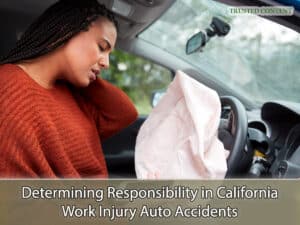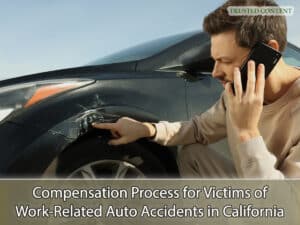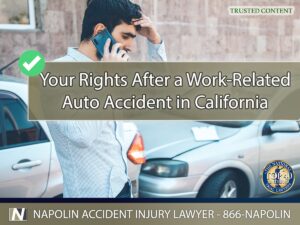Understanding Your Rights After a Work-Related Auto Accident in Ontario, California
When involved in a car accident while on the job, understanding your legal rights and responsibilities is critical. This article offers a detailed exploration of the complexities of work-related vehicle accidents in California, providing crucial insights for employees and employers alike. Navigating the aftermath of such an incident requires a clear understanding of the legal landscape to ensure all parties involved can make informed decisions and pursue the appropriate avenues for resolution and compensation.
Understanding Work-Related Vehicle Accidents
Work-related auto accidents in California can vary widely, ranging from minor fender benders in company parking lots to serious collisions during business trips. Each scenario might involve different legal considerations regarding liability and compensation. Whether the vehicle is owned by the company or the employee can also affect the determination of liability. In addition, the reason for the employee being on the road, whether it’s commuting to work or performing a task from the job description, can influence how claims are handled legally.
For instance, a sales representative traveling to meet a client in a company-owned vehicle may be considered under the scope of employment, thus potentially making the employer liable for any accidents occurring during the trip. Conversely, an employee running a personal errand during a lunch break, even if using a company car, may not be covered under the same legal principles. Understanding these distinctions is key to determining liability and navigating the claims process effectively.

Determining Responsibility in California Work Injury Auto Accidents
Determining Responsibility in California Work Injury Auto Accidents
Accurately determining responsibility in work-related accidents is crucial for processing claims and providing compensation. Here’s a structured approach to evaluate liability:
- Assessment of the Accident Scene: Documentation and investigation of the accident site provide initial clues about what happened and why. This includes collecting testimonies from witnesses, inspecting the vehicle for defects, and reviewing any available video surveillance.
- Analysis of Employee's Role: Evaluate whether the employee was engaged in job duties at the time of the accident. This involves checking the employee’s schedule, tasks at the time of the incident, and whether the journey was work-related.
- Consideration of Employment Terms: Review the employment contract and company policies related to vehicle use and employee responsibilities on the road. Some contracts specify conditions under which an employee is considered to be on duty.
- Vehicle Ownership: Determine whether the vehicle involved in the accident was owned by the company or the employee. Company vehicles typically shift more responsibility towards the employer, especially if poor maintenance played a role in the accident.
- Legal Compliance Checks: Verify adherence to both traffic laws and workplace safety regulations. Non-compliance can shift fault significantly, influencing the outcome of liability determinations.
This systematic approach ensures that all relevant factors are considered when determining who is legally responsible for a workplace accident. It helps in resolving claims efficiently and ensures that all parties receive fair treatment under the law.
Legal Principles Governing Work-Related Accidents
California’s approach to work-related vehicle accidents is governed by both employment law and traffic regulations. Employers may be liable for accidents that occur during an employee’s work-related activities under certain conditions. This includes scenarios where the employer could have foreseen the risk and prevented the accident through proper training or vehicle maintenance. Understanding these principles is essential for anyone involved in a work-related vehicle accident.
Employment law in California typically considers the concept of ‘scope of employment' to assess employer liability. This legal doctrine evaluates whether the employee was performing job-related duties at the time of the accident. This means if an employee is involved in an auto accident while performing their job duties, the employer might be liable for damages. This liability arises not from the employer’s direct actions, but from their role in empowering the employee to act on their behalf. The nuanced nature of these cases often requires a thorough investigation into the exact circumstances surrounding the incident, including the time, location, and purpose of the journey.

Compensation Process for Victims of Work-Related Auto Accidents in California
Compensation Process for Victims of Work-Related Auto Accidents in California
In California, workers' compensation offers essential support for employees injured in work-related auto accidents. This no-fault system streamlines the process of obtaining medical care and compensating for lost wages. Here is a condensed overview of the workers' compensation process:
- Report the Accident: Injured employees must report their accident to their employer within 30 days to maintain eligibility for benefits.
- Seek Medical Attention: Immediate medical care is crucial, and employees should inform healthcare providers that the injury is work-related to ensure proper documentation.
- Claim Filing: Employers must provide a workers' compensation claim form (DWC 1) within one working day after the accident is reported. The completed form is then submitted to the insurance carrier by the employer.
- Claim Processing: The insurance carrier evaluates the claim based on medical records and accident reports and decides on eligibility for benefits.
- Approval or Denial: Employees will be notified of the claim's approval or denial within 90 days. Approved claims result in benefits for medical expenses and lost wages, while denials can be appealed.
- Continuous Care and Adjustments: Approved claims may require ongoing medical care and adjustments to benefits, depending on recovery progress.
- Return to Work or Settlement: The process concludes with the employee’s recovery and possible return to work or through a settlement, particularly in cases of long-term disabilities.

Understanding Your Rights After a Work-Related Auto Accident in California
Understanding Your Rights After a Work-Related Auto Accident in Ontario, California
Understanding the intricacies of work-related auto accidents in California is vital for navigating your legal rights and options effectively. If you have been involved in such an accident, contact Napolin Accident Injury Lawyer at (909) 962-8415 for a free consultation. Our extensive experience in handling work injury cases ensures that we can provide you with the skilled legal representation you need to secure just compensation.
Dealing with the aftermath of a work-related auto accident can be overwhelming. It's not just about recovering physically but also ensuring that your legal rights are protected. Employers and employees must understand their rights and responsibilities to manage the situation effectively and ensure that all parties are fairly compensated. Legal expertise is crucial in these cases, not only to navigate the complexities of the law but also to advocate for the rights of those impacted by such incidents.
